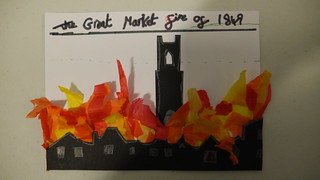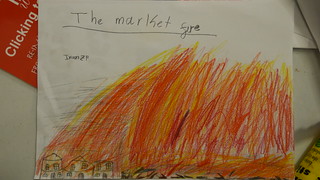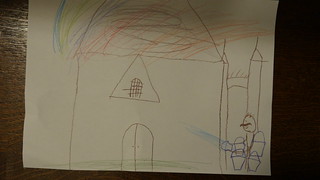I) The Fire of 1849 in Market Square
Summary
On the night of Saturday 15th September 1849 there was a huge blaze which came to be known as the Great Fire of Cambridge Market. It started in a textile shop but became out of control once a chemist caught fire, because the chemicals for the medicines blew up like a firework display! The townspeople tried to put out the fire with buckets from Hobson's fountain, but the key was missing, so water had to be brought up from the River Cam behind King's Chapel in a long human chain which took too much time. All the old timber structures of the market area were destroyed, which is why you see stone and brick buildings by the market today.
Story
This history trail is narrated by the poet Michael Rosen, with script researched by Helen Weinstein and the team at Historyworks. This recording is part of a series of Cambridge history trails which have lyrics inspired by 'history beneath our feat' performed by local schoolchildren, with poems by the top poet Michael Rosen and songs by the funny team at CBBC's songwriters commissioned by Historyworks.
The Cambridge market was founded in Saxon times and grew in size during the Middle Ages. Cambridge was a very important trading centre in East Anglia. And hosted the annual Stourbridge Fair on the outskirts of town - the biggest fair in England! At the weekly market lots of different items were sold in the market, such as fruit and vegetables, fish, timber, stone, and coal.
Cambridge was in the middle of the fens so almost everything had to be brought in by boat on the Cam, which joins the Ouse and reaches the sea at King’s Lynn. Some goods came all the way from Europe. The City’s Coat of Arms, issued by Elizabeth I, showing Seahorses, the Great Bridge and the River Cam with boats, is set above the Guildhall door on the south side of the square. The elements in the Coat of Arms demonstrate how important river trade was to Cambridge.
Streets were often named after the goods that were sold there, but because the market is so old, many of the words have changed over time. What do you think was sold on Peas Hill? It wasn’t peas! ‘Peas’ is a corruption of the Latin ‘pisces’, meaning fish.
Big public events were held in the marketplace, including executions. Queen Mary I, also called Bloody Mary, ordered that the leading Protestants of Cambridge be burnt at the stake in the marketplace. Two of these Protestants, Martin Bucer and Paul Fagius, were already dead! That didn’t stop Mary: she ordered their corpses dug up and burnt anyway.
We have a song about Martin Bucer written by Dave Cohen, the CBBC Horrible Histories Songwriter. You can listen and sing along to it on the website.
In the middle ages, Cambridge was a very smelly place. The college’s toilets emptied into the river, and the dirty water spread diseases. To help clean up the city, the town and university had a substantial donation from a local man named Thomas Hobson to build a waterway that would bring in fresh water from the countryside. It was known as Hobson’s Conduit (commonly called Hobson’s River) and you can still see a small section of it today, running in ditches on either side of Trumpington Street, outside the Fitzwilliam Museum. In the Market Square a fountain was built in 1614 to give clean drinking water to the people of Cambridge. This also marked the end point of Hobson’s Conduit. The remains of the fountain can be seen today in the centre of the market square looking like a giant flower pot!
Thomas Hobson had made his money by organising the carrying of messages from London to Cambridge for which he stabled about forty horses at his inn…
His main job was organising the carrying of messages on horseback between London and Cambridge for which he stabled about forty horses at his inn. But as he owned more horses than he ever needed, he decided to start renting them out at short notice. He provided boots, bridles and whips so the academics and university students, who were his main customers, could set out straight away. To those who had used his horses but had nowhere else to stay in Cambridge he also offered board and lodging at his Inn. He was the first person in England to set up such a business!
He was a shrewd businessman, no doubt about it, and soon noticed that his customers always wanted the fastest horses, which left those horses tired and overworked, and others unused. So he placed all his horses in a single line, only offering customers the horse at the front, a bit like the taxi ranks of today! The choice was “take it, or leave it” - Hobson’s choice! In other words – no choice at all!
The Cambridge Marketplace is what it is today as a result of the Great Fire. This took place on the night of Saturday 15th September 1849, when a blaze broke out at half past midnight at a clothier’s shop full of textiles. In those times, there were wooden houses and workshops erected like a shanty town in the middle of what is now the Market Square, and spreading down Petty Curry and Peas Hill.
Even Great St Mary’s had shops with upstairs dwellings leaning on the east wall, which meant if you looked up in church you could see into neighbours’ bedrooms! It was therefore easy for a fire to spread because of the clusters of wooden structures.
Water from Hobson’s Fountain should have been used to quickly put out the fire, but the key to the conduit had been mislaid in the panic so the townspeople had to put the fire out with buckets, forming a long chain from the river. Newspaper reports describe when the chemist shop caught fire, that the chemicals turned the flames every colour of the rainbow like a firework display! Thankfully no-one died when many structures in and around the market were burnt to the ground. But the extra space gave the marketplace its modern shape
Thankfully no-one died when many structures in and around the market were burnt to the ground. But the extra space gave the marketplace its modern shape and because the market was so important, almost all of the town’s biggest buildings were located around the square. These included Great St. Mary’s Church; the Guildhall (built on the site of the old Jewish synagogue) ; and the gaol. Most of these buildings were rebuilt by the Victorians.
After the huge fire devastated the Square, Hobson’s fountain was moved to the corner of Lensfield Road, here you can also see a reconstructed conduit from 1953. Today, you can find the pieces of the original Hobson fountain from Market Square on display in the courtyard at the Museum of Cambridge and you can hear about Hobson and his horses in a song and a round written by Dave Cohen, the CBBC Horrible Histories Songwriter. You can listen and sing along to it on the website.
The market continued to be very important for the Victorians, but the new railway meant that goods arrived by train, not barge. Today, the market continues to be at the centre of Cambridge life, just as it has been for a thousand years.
Created with flickr slideshow.
Here are some artworks illustrating this story produced at the Historyworks event in Great St Mary's:





